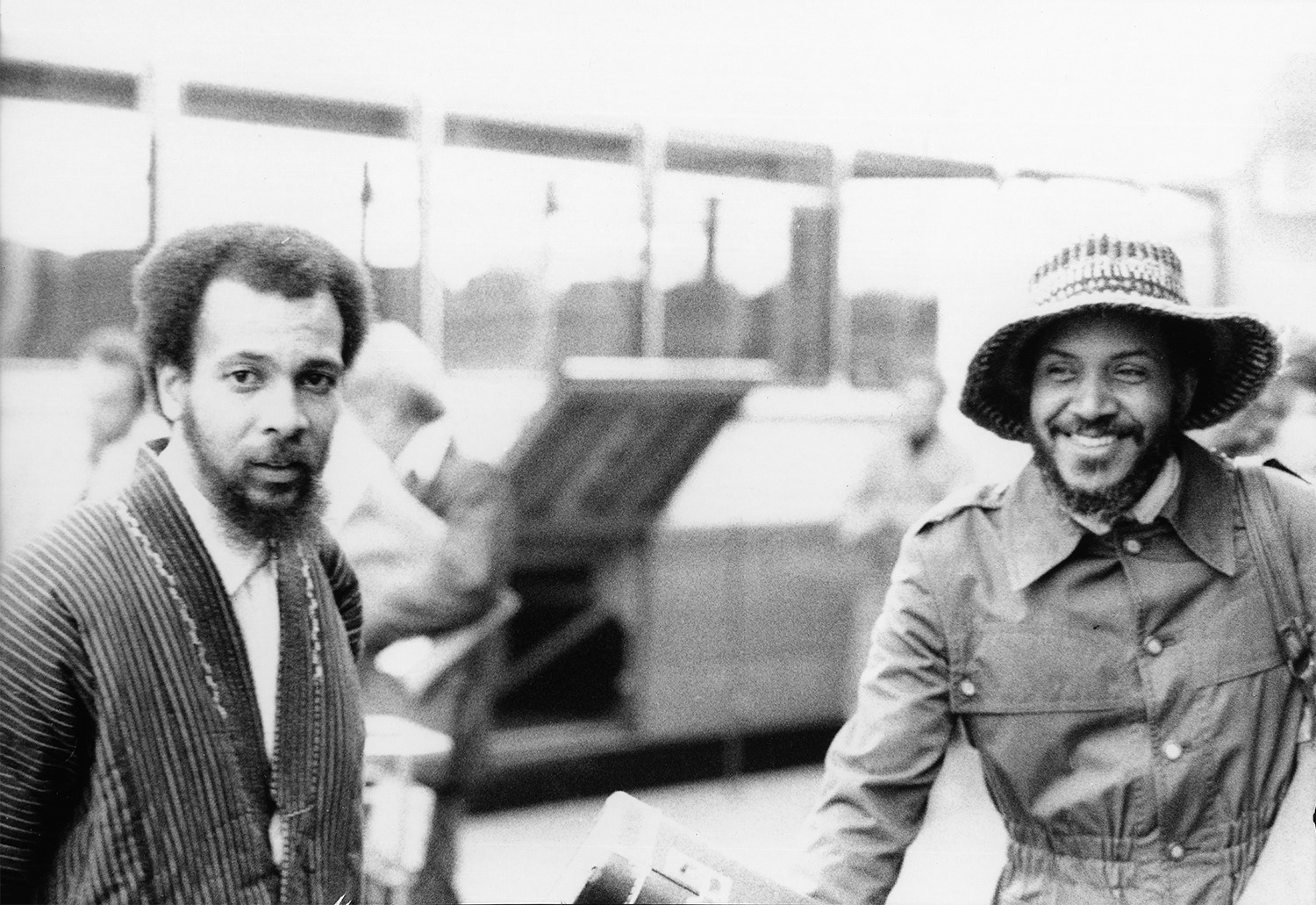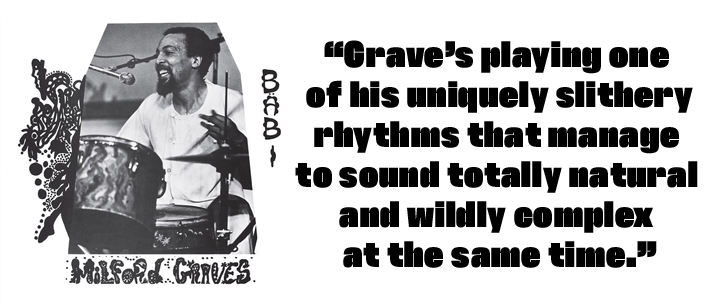GRAVES/DOYLE/GLOVER: “CHILDREN OF THE FOREST”Inside the clubhouse run by the Free Jazz Collectors Guild, few LPs are as revered as Bäbi, the 1977 album by Milford Graves, playing live in trio with reedmen Arthur Doyle and Hugh Glover. The session took place at WBAI's “Free Music Store,” which was a weekly series of live radio shows (featuring everything from Archie Shepp to Renaissance music to Patti Smith to Bread & Puppet Theater) originated by Eric Salzman, which ran from 1969 and 1976. Bäbi was the fifth and final LP issued on the IPS (Institute of Percussive Studies) label, which Graves and Andrew Cyrille founded in 1974 when they had trouble interesting extant labels in some of their percussion heavy projects. Sadly, Bäbi has still not been reissued on vinyl, although Corbett Vs. Dempsey put out a fine 2CD reissue abetted with some tracks recorded prior to the actual broadcast.
Suffice to say Bäbi is a howler. It was the first time Graves had recorded as the leader of anything apart from percussion ensembles, and the way his mastery of all known pulses weaves its way through the blazing skronks of Doyle and Glover is quite astounding. These three had begun playing together in 1969 (as evidenced on the Babi CD set), and seven years later they have a pretty incredible way of moving sheets of sound around and through each other's auras. It is surely one of the most explosive and powerful albums of pure Fire Music extant, and is highly recommended to anyone who doesn't know it.
That said, Children of the Forest is an equally brilliant and whacked-out set that is certain to be one of 2023's signal archival finds.
 Milford Graves and Hugh Glover, arriving in Paris in 1973. Photograph by Thierry Trombert.
Milford Graves and Hugh Glover, arriving in Paris in 1973. Photograph by Thierry Trombert.Graves was one of those guys who did so many different things that his activities always had a semi-legendary quality to them. He taught at Bennington with Bill Dixon. He was an herbalist and a martial arts master. He could control his heartbeat. He was the resident shaman of his community in Queens, and would only play for free in his own neighborhood... these rumors and more (many of them based in truth) hovered around Graves's mystique.
There were years in the '60s when Milford recorded a ton. His 1965 releases include Giuseppi Logan Quartet, Montego Joe's Wild & Warm, the first two NY Art Quartet LPs, The Percussion Ensemble LP with Sonny Morgan, Myriam Makeba's Makeba Sings, Paul Bley Quintet's Barrage and Lowell Davidson Trio (five of these on ESP-Disk’). But after '77 (when he also released an LP with all Japanese free players, Meditation Among Us), his next LP was not until '84 when he played in a percussion quartet for an album on Soul Note called Pieces of Time. Graves was known to constantly workshopping in his Queens hideaway, but even from Manhattan his presence was spectral and sightings were rare. Of course, you probably know all this already since you have no doubt seen Milford Graves Full Mantis, the excellent 2018 documentary directed by Jake Meginksy with Neil Cloaca Young. Jake was a long-time student of Milford's and the movie is a beautiful testament to Graves's power and weirdness. If you haven't seen it, rectify that promptly.
Jake's interview with Hugh Glover is on an insert included with the Children of the Forest set, and provides a lot of insight into the evolution of this trio's approach to sound creation. But it does not tell us much about Glover himself, who is really kind of a mystery man. Hugh reportedly met Graves back as far as Bill Dixon's October Revolution in Jazz series in 1964. He has a really unusual and powerful reed tone, especially when things get a little harsh. But his only released recordings prior to Children of the Forest are Bäbi and one track with Milford on Folkways's 1975 New American Music Volume 1 comp. No real idea why he didn't record more, but one assumes his devotion to the music of Milford is parallel to that which John Gilmore evinced for Sun Ra. Both of them surely could have secured a lot more work than they did, but chose to follow the paths they felt destined to.
Doyle has much more recording history behind him. He also came up in the '60s and played a lot live when he hit NYC, but never recorded until Noah Howard got him to wail on The Black Ark in '72. He had met Graves back when Milford was playing with Ayler, at the John Coltrane Memorial concert in '67, but Arthur's early discography is scant. After Bäbi, he released the classic Doyle + 4 LP, Alabama Feelings on Charles Tyler's AK-BA label, but apart from a track on the Noise Fest cassette and a spot with Alan Silva's big band on Desert Mirage, there was nothing else until he put his troubles with French authorities behind him and came back to NYC to record with Rudolph Grey in the '80s.
Eventually this resulted in a great amount of interest in Doyle's latter-day trajectory, although by then some of his raw power had been supplanted by something far weirder. Apropos of this, ESP-Disk's Bernard Stollman once told me that he had tried, without success, to track down both Doyle and Charles Gayle (another highly idiosyncratic sax voice) in the '60s. So, I guess Arthur was even more of a ghost than Milford back in the day.

The tracks on Children of the Forest were recorded on three dates in early 1976.
The whole of the first LP of the set was done by the full trio on March 11th, and the three tracks have different though related aspects. “Part I” begins with Graves's playing one of his uniquely slithery rhythms that manage to sound totally natural and wildly complex at the same time. Doyle is ripping on tenor, and Glover blares a series of strangely-subterranean sounding hoots from what I guess is a klaxon (a variation on the one-note horns cars used to use back in the Model T days.) It is a truly bizarre mix, but is all welded together by Graves's darkly magical pulse. On “Part Two” Graves goes more widely lateral, expanding his percussive reach in all directions, and Doyle sounds like he's a man-sized dirigible being squeezed by a boa constrictor. It's full of ferocious flat-out screaming with an ending as brutal as a car wreck. On “Part Three” Milford starts off in a full omni-directional mode with Doyle on power flute, which he plays with the glazed ferocity of Jajoukan piper, while Glover creates unbelievable sounds (like a jackal vomiting) presumably using a vaccine (a Haitian single note horn) — an instrument I had never even heard of before this. It's like an artistic soundtrack for a movie documenting traffic jams in deep space. And finishes up with a few minutes from an unnamed documentary about forest tribes in the Congo.
The second LP has four tracks recorded by Graves and Glover as a duo on January 24th. Glover is on tenor for this session, and while his tone is not as explicitly fever-wracked as Doyle's, he has a way of pushing against the upper edges of the freak register that is a raw and quivering as any meat wheel in the universe. On the first track it sounds like his horn is trying to explain the meaning of dream states, and the third track has some short horn statements that almost feel balladic inside the context of the whole album. And throughout, Milford proves again and again that his mastery of playing goes beyond musical concepts into realms of pure magic.
For the final track, recorded February 2nd, Milford plays unaccompanied in a way that feels a bit more “conventional” at first, until you realize he's driving three distinctly different rhythmic spikes through your skull simultaneously.
Reportedly, this set was envisioned, just like this, as a Milford album that never managed to get released. There's supposed to be more coming from his archives as well. And I, for one, cannot fucking wait.
—Byron Coley
